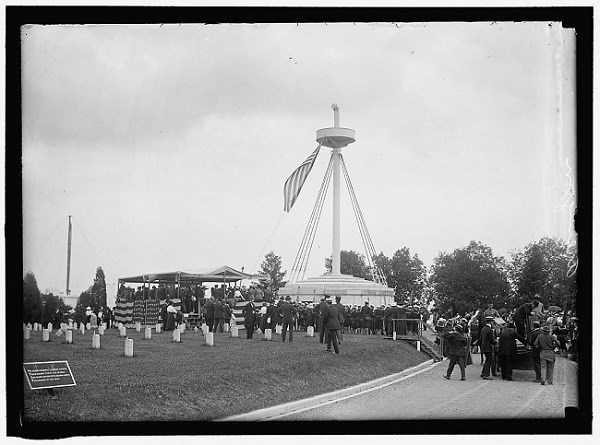The HPTC established the Project Management (PM) Section in 2005 to meet the National Park Service’s growing need for planning and project management services related to cultural resource maintenance and preservation. The PM team complements HPTC’s existing training and preservation services by offering project planning, design and construction management services, and comprehensive project oversight. The PM Section offers services which span from project planning to project completion. The strength of the Section is its ability to develop successful project teams, which in turn, result in successful preservation projects.

Library of Congress
Featured Project: Project Management
Arlington National Cemetery, Arlington, Virginia
Project: USS Maine Memorial Restoration
Significance of the Resource:
The USS Maine Memorial, located in Arlington National Cemetery, honors the seamen who lost their lives on the United States Navy’s second commissioned battleship. On January 25, 1898, the battleship sailed into Havana Harbor to protect US interests during a time of Cuban revolts against Spain in the Cuban War of Independence. Instead, on February 15, 1898, the USS Maine experienced a deadly explosion and sank, ultimately killing 266 men. The sinking of the Maine has been historically remembered as the force that propelled the United States into the Spanish-American War.
The USS Maine Memorial was designed and constructed from 1913-1915. It consists of the main mast, removed from the USS Maine, and set upright into the center of a circular, stylized mausoleum shaped to look like a battleship gun turret. The slightly domed roof is topped with stone “shingles”. The original design featured ship’s rigging, the ropes that support the masts and move the sails.

HPTC/NPS
Why Are We Doing the Project:
Many years of deferred maintenance resulted in severe roof leaks, interior flooding, deterioration of the stone walls and mast, and loss of the rigging. In the early 2000s, in anticipation of the 100th anniversary of the memorial’s dedication, the US Army Corps of Engineers and Arlington National Cemetery (ANC) engaged the HPTC’s Architecture Team to conduct a condition assessment of the memorial.
Based upon the findings of that 2007 Historic Structure Assessment Report and the sincere desire to bring the memorial back to good condition, ANC entered into an agreement with the HPTC Project Management (PM) Section. The goal--to do additional technical investigation, develop construction documents and oversee the memorial’s restoration.

HPTC/NPS
How Is This Done?
The PM Section works with the NPS and other federal agencies much like a general contractor works with a homeowner. We represent our client’s interests, and coordinate with the technical specialists who carry out the work. But we also ensure the work meets the Secretary of the Interior’s Standards for the Treatment of Historic Properties.
For this project, we worked with an architectural firm and their team of preservationists, material analysts, environmental engineers, and structural engineers. They created baseline drawings, reviewed the existing conditions, and developed treatment recommendations.
To more accurately define the existing conditions and plan the repairs, we needed additional testing and investigation.
-
Selective demolition and dismantling allowed the structural engineers to inspect the conditions of the steel mast’s footing and understand how the memorial’s perimeter foundation was constructed.
-
A smoke test determined the porosity of the mast’s water-saturated concrete fill.
-
The mortar of the stone “shingle” setting bed was analyzed and compared with original project specifications. The analysis also helped us develop recommendations for replacement material.
-
Inspecting the built-in gutter helped us identify the source of water seeping into the walls and flooding the memorial’s interior space.

HPTC/NPS
ANC reviewed the test reports and selected their preferred treatments, allowing the PM Section to continue the process for carrying out this complex and highly visible project. The next step was working with the contracted architectural team to develop design and construction documents.
Even during this design phase, testing continued. After identifying the goals for tasks like bronze conservation or cleaning marble, we evaluated various methods and documented the steps of the successful method. This allowed us to accurately specify the required treatments and clearly communicate our expectations..
Once the design and construction documents were finalized and met ANC’s approval, we developed the contract package. The package was then forwarded to the NPS Contracting Officer (CO) who then created and issued the solicitation package. The solicitation was advertised on The Federal Business Opportunities website at www.fedbizopps.gov.
After we received proposals, a panel of stakeholders convened to review the technical proposals and determine which offerors were technically acceptable to carry out the project. The CO held negotiations with these offerors. Once the CO awarded the contract, the PM section provided construction management services for the duration of the construction contract. This involved ensuring contractors used the methods and materials that we specified after all the testing and investigating and met the goals of ANC..
Some of the contractors we worked with were metal conservators, sheet metal workers, painters, and masons. To restore the original configuration of the memorial rigging, the HPTC collaborated with the a rigger from San Francisco Maritime National Historical Park. These true preservationists investigated, designed, and installed an appropriate an intricate rigging system.
You can watch a video overview of Maine’s restoration.
Last updated: March 29, 2022
